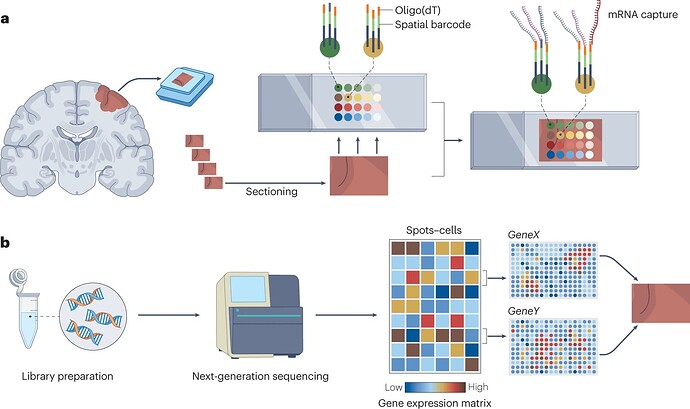It seems like there is more and more talk of single cell sequencing these days, so I thought I’d share a bit about what that looks like in the CNS, with single cell, single nuclei, and spatial transcriptomic approaches. This review paper from the Rybak-Wolf lab is a great resource!
Experimental pipeline of a droplet-based single-cell RNA sequencing in a nutshell. (Piwecka et al., Nature Reviews Neurology, 2023)
For single cell or single nuclei RNA-Seq, one big advantage of single nuclei over single cell RNA Seq is that it can be applied to tissues/cell types that are difficult to dissociate, such as neurons from postmortem brain, which is relevant for neurodegenerative disorders. Additionally, single nuclei isolation can be more easily applied to cryopreserved tissues, which are often what are stored in brain banks. There are also assays that use nuclei and not cells, such as the Multiome ATAC + GEX assay from 10x genomics. One important thing to keep in mind when looking at single nuclei data (as opposed to single cell data) is that there are more introns present, since you are capturing more pre-spliced transcripts in the nucleus (as opposed to the cytoplasm). For data from 10x genomics, this means processing with the --include-introns option.
While single cell/single nuclei data gives ideas about cell types, states, activation, and new or rare cell types, spatial transcriptomics can provide insight about the relationships of tissue organization.
Spatial transcriptomics: the principle and workflow (Piwecka et al., Nature Reviews Neurology, 2023)
A combination of these approaches is being used to study neurodegeneration at the cellular level, and I’m excited to see more discoveries in the future in this area. Some existing studies are shown below.
Single-cell RNA-sequencing, single-nuclei RNA-sequencing and spatial transcriptomics studies reveal cellular and molecular heterogeneity in human neurological disorders (Piwecka et al., Nature Reviews Neurology, 2023)
If you’re interested in one of these datasets in PD - @vdardov is leading a webinar this Wednesday, April 3rd at 4pm EST on the AMP PD postmortem brain snRNA-Seq data. Go check it out!


